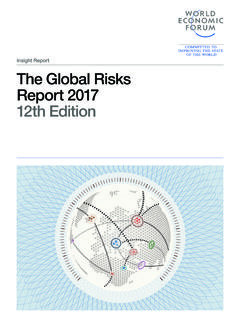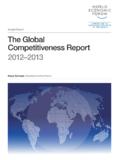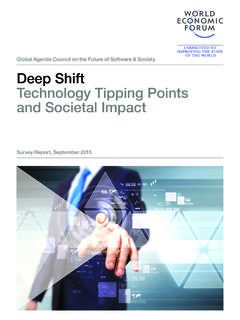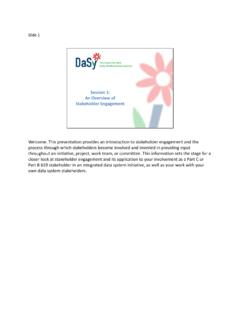Transcription of Fostering Effective Energy Transition 2021 edition
1 INSIGHT REPORTAPRIL 2021 Fostering Effective Energy Transition2021 edition346101518192021232426262727293131 3235353639394043444546 Fostering Effective Energy Transition 2021 edition2 ForewordExecutive summary1. Introduction2. The Energy Transition Index in a decade to deliver3. Overall results4. Sub-index and dimension trends Key findings System performance Economic development and growth Energy access and security Environmental sustainability Transition readiness Regulation and political commitment Capital and investment Energy system structure5. Building resilience to overcome new risks Societies and policy The risk landscape Considerations to build a resilient Transition Energy systems and technologies The risk landscape Considerations to build a resilient Transition of Energy systems and technologies Finance The risk landscape Considerations to build resilient finance to support the transition6.
2 ConclusionAppendixContributorsEndnotesCo ntents 2021 World Economic Forum. All rights reserved. No part of this publication may be reproduced or transmitted in any form or by any means, including photocopying and recording, or by any information storage and retrieval : GETTY/InakiantonanaInside: All photos GETTY/AvigatorPhotographer; Nikada; rusm; Liam Matter; Kontrast-fotodesign; Tongpatong; Federico Rostagno; Scharfsinn86; Genkur; Viktoriia Hnatiuk; ImantsuFostering Effective Energy Transition 2021 editionAPRIL 2021 Fostering Effective Energy Transition 2021 edition3 This edition marks the 10th anniversary of the Energy Transition Index (ETI). In the past decade, we have witnessed an unprecedented acceleration of the Energy Transition . Two examples illustrate the point: the growing speed of renewable Energy penetration (particularly wind and solar), and the important strides made in Energy access.
3 These changes have been facilitated by several factors, among which technological advancement and growing political support stand out. However, extraordinary as this evolution has been, there remain some critical challenges to delivering sustainable and affordable Energy while improving access and security. A year has passed since the world was hit by what became the greatest global health challenge in over a century. The crises generated by the COVID-19 pandemic continue to affect countries across the world in multiple ways, underscoring key unsolved societal issues. For example, as economic development has stumbled or reversed, the health emergency has exacerbated inequality and hampered efforts to tackle Energy poverty. Unilateral approaches adopted by governments in their handling of challenges during the pandemic, from personal protective equipment to the approval and dissemination of vaccines, have also raised concerns about the international community s ability to come together in coordinated action across countries and sectors.
4 Moreover, uneven compliance to recommended public health measures, driven either by economic reasons or differences in values, illustrates the challenges in mobilizing all sections of society in a cohesive response to a shared problem. The latter is critical as we look to take Effective collective action on Energy we published last year s ETI and discussed its findings, we were only a few months into the pandemic. We talked about how Energy systems were subject to compounded disruptions and we wondered what a new normal would look like. Some of the questions raised at that time have been answered, but many important pieces in this complex, evolving puzzle have not yet been put together. The actions we take in the early years of this decade of delivery and action will be critical in ensuring that strong, long-term ambition is supported by concrete, immediate progress.
5 We are eager to see stimulus and recovery packages playing an important role in this report discusses the key findings from the Energy Transition Index 2021. For this report, we have made a few changes in the methodology to reflect the rising sense of urgency of climate change, and we have refreshed some the indicators to use available data more effectively. The ETI supports decision-makers with a transparent fact-base on the progress and gaps in the Energy Transition , the complexity of that Transition , and its interdependence with social, political, environmental, economic and institutional elements. Coming out of a challenging 2020, and based on discussions with key global experts, this edition pays special attention to the climate component. In addition, we address how to improve the robustness and resilience of the Transition and how to tackle elements that could derail the successful transformation of our Energy of the key findings is a call for coordinated, multi-stakeholder action to achieve an Effective Energy system evolution.
6 To that end, the World Economic Forum encourages the sharing of leading practices and the use of its platform for public-private collaboration to facilitate the process of Energy Transition around the Bocca Head of Shaping the Future of Energy , Materials, and Infrastructure, Member of Executive Committee World Economic ForumMuqsit Ashraf Senior Managing Director and Global Energy Industries Lead, AccentureStephanie Jamison Senior Managing Director and Global Utilities Lead, AccentureForewordFostering Effective Energy Transition 2021 edition4 The past decade has established the strong initial momentum to transform the Energy system for the decades ahead. The scaling of nascent technologies and an increased focus on climate change have fixed global attention firmly on the decarbonization of Energy journey is far from over. As of 2018, 81% of the world s Energy was still supplied by fossil fuels,1 global greenhouse gas emissions rose through 2019 and more than 770 million people around the world still lack access to The transformation of our Energy systems needs to increase its momentum to help achieve critical objectives such as the UN s Sustainable Development Goals and the Paris Agreement.
7 A decade into the Energy Transition marks a new high, but acceleration is requiredThis edition marks the 10th anniversary of the World Economic Forum s benchmarking of countries on their Energy Transition progress. We have taken the opportunity to look back at the lessons learned from the past decade, while also looking forward to the journey ahead. Aggregate ETI scores rose over the past decade for countries collectively accounting for 86% of global total Energy supply and for 88% of global CO2 emissions from fuel combustion. The ranking of top countries on the ETI has remained broadly consistent over the past decade. Denmark, Finland and the United Kingdom, highest improvers in the top 10 positions, were able to improve their Energy system performance and sustainability outcomes thanks to a stable regulatory environment, diversified Energy mix and cost-reflective Energy pricing.
8 Countries with rising Energy demand, such as China, India and Sub-Saharan African nations, have registered the largest gains, but their scores on the ETI remain low in absolute terms. Strides made on Energy access; reliability is the next frontierOver the past 10 years, more than 70% of the countries in the ETI made progress on the Energy access and security dimension, primarily due to improvement in levels of electricity access around the world. However, more efforts are needed to improve the quality of electricity supply in newly electrified areas. This is critical for the delivery of public services, such as testing and vaccination programmes for COVID-19. Moreover, increasingly frequent and unpredictable extreme weather events have exposed the vulnerability of grids, underscoring the urgent need to modernize and enhance the resilience of electricity transmission and distribution infrastructure.
9 Strong gains made in environmental sustainability, but significant gaps remain Encouraging progress has been made in environmental sustainability over the past 10 years, with countries accounting for 88% of global total Energy supply improving their scores on this dimension. Global average Energy intensity fell by 15% between 2010 and 2018. However, this improvement has yet to fully translate into meaningful gains, as the carbon intensity of the Energy mix was broadly flat over the same period. While there has been encouraging progress in areas such as rising levels of investment and political commitment, progress has been far slower in translating ambitions into actions and in realizing the transformation of the Energy system structure itself. The total amount of electricity generated from coal has been on an upward trajectory over the past 10 years.
10 Identifying viable ways for the early retirement of carbon-intensive assets will be needed to accelerate the the resilience of Energy transitionOver the past 10 years, only 13 of the 115 benchmarked countries have made consistent gains (defined as consistently above-average performance improvements on the index). This demonstrates the difficulty in sustaining progress and the complexities of the Energy Transition . Systemic disruptions such as the pandemic have underscored the impact of external shocks. The Energy Transition has shown signs of resilience Executive summaryFostering Effective Energy Transition 2021 edition5through COVID-19, which highlighted the resilience of renewables in However, despite the short drop in emissions during the pandemic, global emissions have since rebounded, according to the International Energy As we head deeper into the decade of action5 during which we must accelerate progress towards Transition and halve emissions by 2030 to remain on track to meet the C Paris Agreement goal we cannot afford to lose momentum or, worse, go into reverse.


















